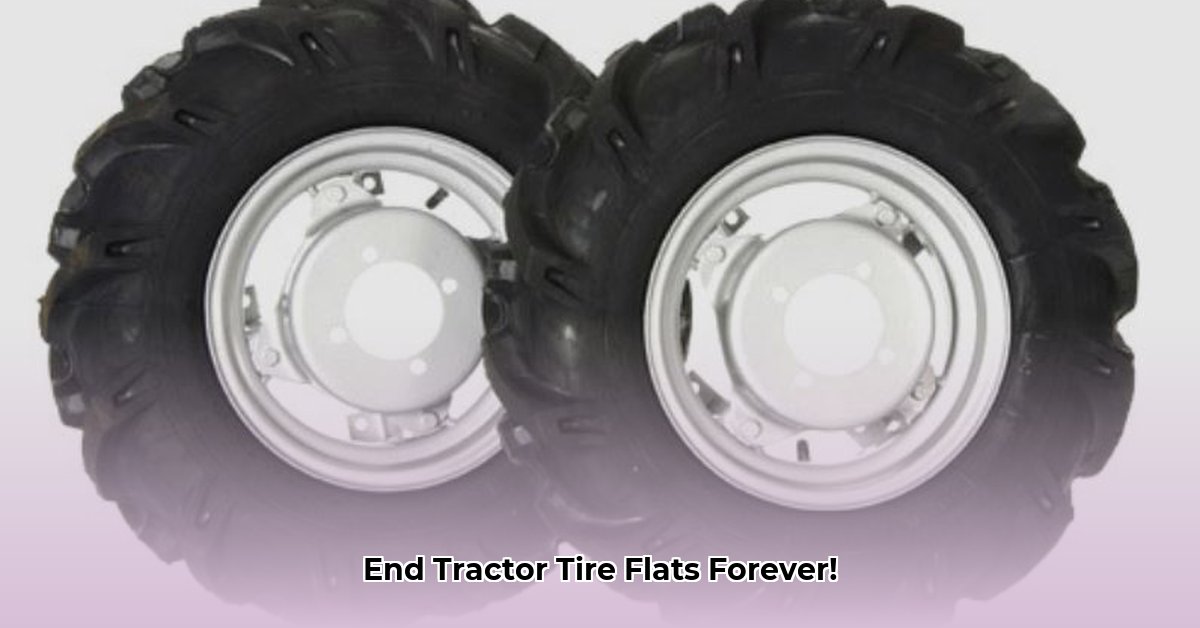
Understanding Foam-Filled Tractor Tires
Dealing with flat tires is a major drain on farm productivity and profitability. Foam-filled tires offer a potential solution by significantly reducing or eliminating flats. This guide provides a practical framework for deciding if foam filling is the right choice for your specific farming operation. We will analyze the advantages, disadvantages, and cost implications to empower you to make an informed decision. To understand tire weight implications, check out this helpful resource on tractor tire weight.
Benefits of Foam-Filled Tractor Tires
Foam filling offers several key advantages:
Reduced Downtime: The most significant benefit is the near-elimination of flat tires, leading to significantly less downtime. This translates directly into increased productivity and higher yields. How much downtime are you currently experiencing due to flat tires?
Improved Traction: The added weight of the foam can improve traction, particularly on hillsides or in challenging terrains. This enhances safety and operational efficiency, especially when using a front-end loader. Have you experienced traction issues leading to accidents or decreased efficiency?
Long-Term Cost Savings: While the initial investment is substantial, the long-term savings from avoided repairs and reduced downtime can quickly offset the upfront costs. This represents a significant return on investment over several years. What is your current annual cost for tire repairs and downtime?
Increased Tire Lifespan: Foam filling can extend the lifespan of your tires by reducing the damage caused by impacts and punctures. This translates to reduced replacement frequency, thus reducing costs and downtime. Do you replace your tires frequently due to damage?
Drawbacks of Foam-Filled Tractor Tires
Despite the benefits, foam filling also presents drawbacks:
High Initial Cost: The cost of foam, installation, and potential rim replacements represents a significant upfront investment. Obtaining multiple quotes from reputable providers is essential to ensure competitive pricing.
Rougher Ride: Foam-filled tires provide a harsher ride, potentially impacting operator comfort and leading to accelerated wear and tear on other equipment components. This increased equipment stress could lead to higher maintenance costs down the line.
Reduced Traction in Specific Conditions: While generally improving traction, foam-filled tires can exhibit reduced grip in very muddy or excessively wet conditions. The reduced flexibility diminishes the tire’s ability to conform to the ground’s surface. Consider your farm's typical soil conditions.
Potential for Increased Equipment Stress: The added rigidity of foam-filled tires can place extra stress on rims, hubs, and potentially other components, increasing the risk of premature wear or failure. Regular inspections are critical to monitor the condition of these components.
Cost-Benefit Analysis: A Step-by-Step Guide
Conducting a thorough cost-benefit analysis is crucial. Follow these steps:
Calculate Current Tire Repair Costs: Track your tire repair costs (parts, labor, downtime) for at least one year to establish a baseline.
Obtain Foam Filling Quotes: Get multiple quotes for foam filling, including the cost of foam, labor, and any potential rim replacements.
Compare Total Costs: Compare your annual tire repair costs with the upfront cost of foam filling. This will give you a short-term financial picture.
Long-Term Projections: Estimate the lifespan of foam-filled tires (potentially longer than standard) and factor in potential increases in equipment maintenance due to increased stress. Amortize the initial cost of foam filling over this period to account for long-term cost savings.
Create a Spreadsheet: Use a spreadsheet to summarize: current annual tire costs, annual cost of foam-filled tires (amortized cost + increased maintenance), and the net annual savings (or cost). This quantitative comparison facilitates informed decision-making.
Practical Considerations: Installation and Maintenance
Tire Selection: Use newer tires in good condition for optimal foam filling performance. Older tires might not hold the foam effectively.
Service Provider Selection: Choose a reputable service provider specializing in agricultural tires and foam filling. Verify their experience and qualifications.
Foam Type: Research different types of foam available and choose one that suits your farm's soil conditions, climate, and tractor usage.
Regular Inspections: Even with foam-filled tires, conduct regular visual inspections to check for abnormal wear, potential damage, and tire condition. Early intervention can save you significant costs in the long run.
Exploring Alternatives to Foam Filling
Consider alternatives:
Puncture-Resistant Tires: Higher upfront costs, but could be cheaper over the long term compared to foam filling, depending on your specific circumstances.
Liquid Sealants: These can help seal small punctures, but are less effective against larger damage.
Conclusion: Making the Right Decision
The decision to foam-fill tractor tires involves a trade-off between upfront costs and long-term potential savings. A thorough cost-benefit analysis, tailored to your specific farming operations and soil conditions, is essential. Weigh the advantages of reduced downtime and improved traction against the higher initial investment and potential for increased equipment wear. Remember to consider the alternatives, allowing you to select the most cost effective and efficient solution for your circumstances.